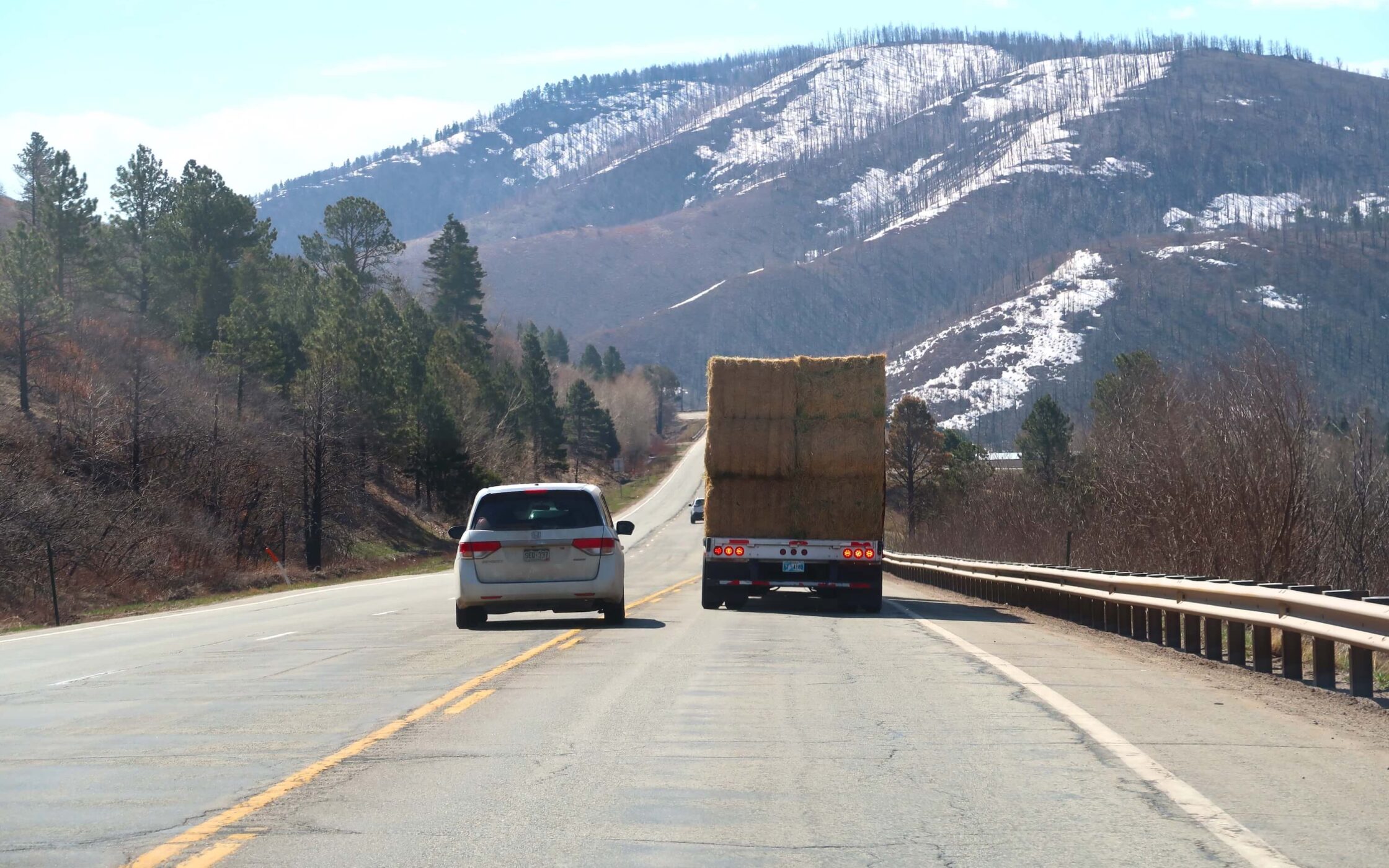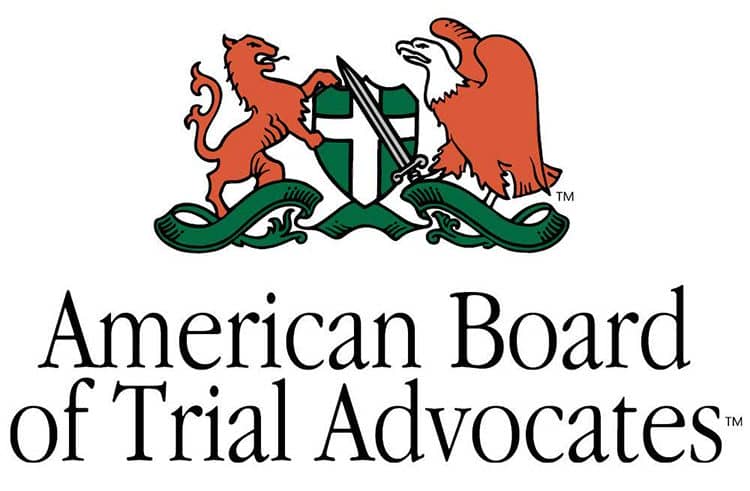Blind spots, also known as “no-zones,” are areas around a vehicle where the driver has limited or no visibility. For 18-wheelers, these blind spots are larger than those of passenger vehicles, making them a major hazard for other drivers on the road.
Awareness of these blind spots can help prevent accidents and ensure safer driving around large commercial trucks. Gingras, Thomsen & Wachs LLP truck accident lawyers can provide you with the strongest legal representation you need to recover maximum compensation for your injuries and losses.
18-Wheeler Blind Spots (Truck No-Zone Areas)
An 18-wheeler’s blind spots pose a danger to other motorists, as the truck’s massive size and restricted maneuverability make sudden adjustments difficult.
Front Blind Spot (Directly in Front of the Truck)
- Extends approximately 20 feet from the front bumper.
- As the truck’s cab is elevated, drivers cannot see vehicles that are too close in front.
- The larger the truck, the longer its front blind spot, especially with sloped hoods or large instrument panels blocking forward visibility.
If a smaller vehicle suddenly slows or stops within this blind spot, the truck driver may not have time to react, leading to rear-end collisions or override accidents, where the truck runs over the smaller vehicle.
Rear Blind Spot (Directly Behind the Trailer)
- Extends 30 to 50 feet behind the truck’s trailer.
- Unlike passenger vehicles, trucks lack a rearview mirror that allows them to see directly behind.
- Limited visibility from side mirrors makes it nearly impossible for the truck driver to detect vehicles tailgating or following too closely.
If a truck brakes suddenly, a following vehicle may not have enough stopping distance, leading to rear-end crashes or even underride accidents, where the smaller car gets lodged under the trailer.
Left-Side Blind Spot (Driver’s Side No-Zone)
- Begins near the cab and extends diagonally from the truck’s side mirror to the rear of the trailer.
- This blind spot is smaller than the right-side blind spot but still significant.
- Limited visibility when merging makes it difficult for truck drivers to detect vehicles passing on the left.
If a driver stays too long in this zone while attempting to pass, the truck driver may not see them, leading to sideswipe collisions or a forced-off-the-road truck crash if the truck shifts lanes.
Right-Side Blind Spot (Larger than the Left-Side Blind Spot)
- Extends several lanes wide, covering the entire right length of the truck and trailer.
- Trucks make wide right turns, often swinging left before completing a turn, which can trap smaller vehicles in the right-side blind spot.
- The truck’s exhaust stacks and frame can further obstruct visibility, making it even harder to detect smaller cars on the right.
If a truck changes lanes or turns right, it could crash or force vehicles off the road, leading to severe or even fatal accidents.
Why Are Trucks’ Blind Spots Dangerous?
Semi truck blind spots create significant risks, including:
- Sideswipe Collisions: When vehicles remain in a truck driver’s blind spot for too long
- Underride Accidents: When a vehicle follows too closely and gets trapped under the trailer during sudden braking
- Turn-Related Crashes: Drivers of large trucks may not see a car in their right-side blind spot when making a wide right turn
How to Safely Share the Road with 18-Wheelers
To minimize the risk of a semi truck accident, follow these safety tips:
- Avoid truck blind spots if possible. If you must pass, do so quickly and safely.
- Pass on the left. The left-side blind spot is smaller than the right-side one.
- Maintain a safe following distance. Stay at least four to five seconds behind a truck.
- Do not cut off a truck. Give at least 20 feet of space before merging in front.
- Be cautious when a truck turns. Never squeeze between a turning truck and the curb.
How Our Truck Accident Attorneys Prove Negligence in a Blind Spot AccidenT
At Gingras, Thomsen & Wachs, our investigative team moves fast to collect critical evidence. Based on strong evidence, we build a powerful case to hold negligent semi truck drivers and their employers accountable for failing to take proper precautions when maneuvering in blind spot areas.
Black Box Data and GPS Records
An 18-wheeler’s electronic logging device (ELD) records speed, braking patterns, and steering inputs. GPS data can show if the truck suddenly veered into another lane or failed to slow down appropriately before merging. This evidence is critical in proving whether the driver acted negligently by failing to check their blind spots before making a maneuver.
Dashcam and Traffic Camera Footage
Video footage from the dashcam of the tractor-trailers, highway surveillance, or nearby businesses can provide critical proof of whether the truck driver checked their mirrors, used turn signals, or recklessly changed lanes. If the footage shows the truck merging into a lane without proper caution, it can establish liability.
Truck Driver’s Logbooks and Hours of Service (HOS) Violations
Fatigue is a major factor in truck accidents. Federal regulations limit the number of hours a truck driver can operate without rest. If logbooks reveal violations or inconsistencies, it may suggest that driver fatigue contributed to the failure to properly check blind spots in the truck’s mirrors before changing lanes.
Truck Maintenance and Inspection Records
Trucks must have properly adjusted mirrors and functional blind spot detection systems. If the trucking company fails to maintain these safety features, it could contribute to a blind spot accident. Our attorneys will obtain maintenance records to determine if defective equipment played a role.
Eyewitness Statements
Testimonies from other drivers, pedestrians, or passengers can provide an unbiased account of how the accident occurred. Witnesses can confirm whether the truck driver failed to check a dangerous blind spot, changed lanes abruptly, or ignored other vehicles in adjacent lanes.
Accident Reconstruction Reports
We may work with accident reconstruction experts to analyze the crash scene, including vehicle positioning, impact points, and road conditions. By reconstructing the sequence of events, we can determine whether the truck driver’s negligence in monitoring blind spots caused the accident.
Medical Records and Injury Documentation
To establish the severity of your injuries and their direct connection to the crash, we collect medical reports, doctor’s evaluations, and medical expert testimony. We will prepare a strong claim for damages that covers the full extent of your injuries and losses, including current and future medical expenses, lost wages, and pain and suffering.
Get Our Experienced Truck Accident Lawyers on Your Side
If you or a loved one has been injured in a car, truck, or motorcycle accident, the dedicated attorneys at Gingras, Thomsen & Wachs are ready to fight for the justice you deserve. With more power, more fight, and the most heart, we have spent decades helping accident victims in Wisconsin and Minnesota recover more than $200 million in compensation.
We work on a contingency fee basis, so you pay nothing unless we win your case. At Gingras, Thomsen & Wachs, we treat every client like family. To schedule your free consultation, call us at 855-954-1186 or contact us online.






